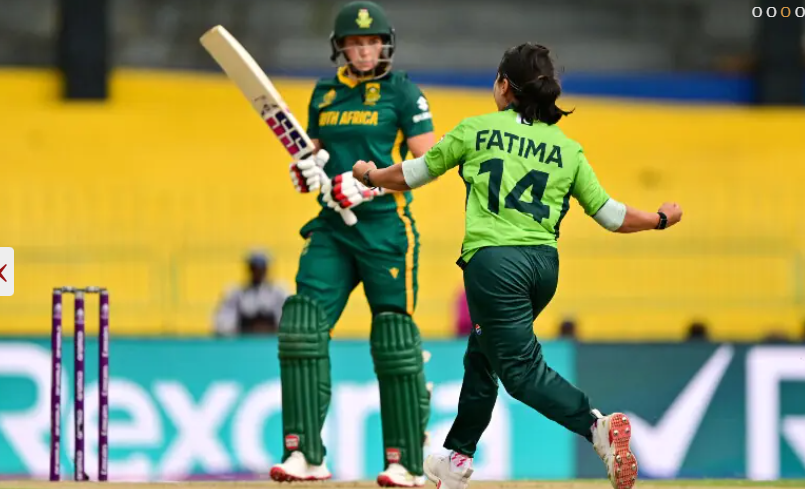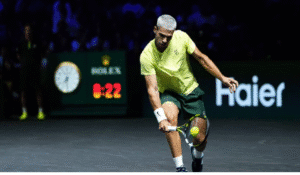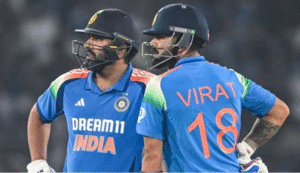Pakistan Crash Out of Women’s World Cup After Crushing Defeat to South Africa

Pakistan’s hopes of qualifying for the ICC Women’s World Cup semifinals ended with a heavy 150-run (DLS) defeat to South Africa in rain-hit Colombo, where Laura Wolvaardt’s brilliant 90 and Nadine de Klerk’s explosive hitting powered the Proteas to a record total.
A Rain-Soaked End to Pakistan’s Campaign
It was a gloomy evening in Colombo — both literally and figuratively — for Pakistan’s women’s cricket team. Fatima Sana’s side entered the R. Premadasa Stadium knowing that only victory could keep their World Cup dream alive. But by the end of a rain-ravaged Tuesday, those dreams were washed away under relentless showers and a dominant South African performance.
The match was chaotic, stop-start, and ultimately one-sided. South Africa piled up 312 for 9 in 40 overs, the highest-ever total by the Proteas in a Women’s World Cup. In reply, Pakistan never got going — losing early wickets, struggling under revised targets, and eventually finishing at 83 for 7, a massive 150-run loss via the DLS method.
When the final wicket fell, the reality sank in — Pakistan’s campaign was over. The dugout sat in silence as South African players celebrated another commanding performance, securing their semifinal spot while sending Pakistan home with one match still to play.
Early Promise, Then the Downpour
Fatima Sana’s Early Strike
Pakistan began brightly. Skipper Fatima Sana, one of the tournament’s most impressive new captains, had chosen to bowl first under heavy cloud cover. Her decision paid immediate dividends.
With just her third delivery, she produced a perfect outswinger that caught Tazmin Brits off guard. The ball kissed the outside edge and flew into the safe hands of Natalia Parvaiz at first slip.
It was the dream start — 6 for 1 after two overs — and Pakistan’s fielders roared in unison. But the joy was short-lived. As players began to take their positions for the third over, the skies opened up. What started as a drizzle quickly turned into a tropical downpour, forcing players and officials to rush for cover.
For nearly two hours, rain dictated the script. The game was reduced to 40 overs per side, and by the time play resumed, the pitch had lost its initial seam movement, the outfield was sluggish, and Pakistan’s early advantage had evaporated.
The Wolvaardt-Luus Masterclass
When play resumed, Laura Wolvaardt — South Africa’s captain and talisman — took complete control. Alongside Sune Luus, she launched a counterattack that left Pakistan’s bowlers searching for answers.
The pair combined for a 118-run stand, the second-wicket partnership that changed the complexion of the game. Wolvaardt, elegant yet ruthless, drove with authority and punished anything short. Luus played the perfect foil — rotating strike, sweeping the spinners, and picking boundaries with precision.
Wolvaardt’s innings of 90 off 73 balls, laced with 11 boundaries, was a captain’s statement. Her cover drives sliced through the field like lasers, and her timing against both pace and spin was immaculate.
Luus’s 61 off 55 complemented her skipper perfectly, ensuring that South Africa’s run rate stayed well above seven an over. By the time both departed, South Africa had crossed 200, and Pakistan’s shoulders had visibly dropped.
“They batted brilliantly. Once the ball got wet, it became really difficult to control swing or grip,” Fatima Sana admitted later. “We tried our best, but credit to them — they were clinical.”
The De Klerk Show: Late Fireworks and Frustration
Just when Pakistan thought they could limit the damage, Nadine de Klerk unleashed mayhem in the death overs.
Arriving at the crease with South Africa at 260 for 6, de Klerk wasted no time asserting herself. She smashed 41 runs off just 16 deliveries, including three towering sixes that silenced the Pakistani bowlers.
Her strike rate of 256 turned a strong total into an unbeatable one. Partnering briefly with Marizanne Kapp, she ensured South Africa finished on 312 for 9 — their highest-ever World Cup total, achieved in just 40 overs.
Every boundary from de Klerk was met with despair in the Pakistan dugout. For a bowling unit that had thrived on discipline throughout the tournament, this was a rare off day.
Fatima Sana, visibly dejected in the post-match presentation, didn’t hide her disappointment:
“Today was the day our bowlers didn’t perform well. We have to accept it. They played very well, but we needed to be calmer in those situations. It was hard to bowl when the ball was wet — but we still should’ve adapted better.”
Rain and Reality: Pakistan’s Chase Becomes Impossible
A Revised Target
As if chasing 313 wasn’t daunting enough, the weather had one final twist. Another burst of rain delayed the start of Pakistan’s innings, forcing a second revision under the Duckworth-Lewis-Stern (DLS) method.
When play eventually resumed, the target was slashed to 234 runs in just 20 overs — a required run rate of nearly 12 per over. It was an impossible task for a batting lineup that has struggled to score quickly all tournament.
Early Collapse
Within minutes, Pakistan’s hopes disintegrated. The top order folded under pressure, losing four wickets for just 60 runs. Openers Sidra Ameen and Muneeba Ali both fell cheaply to South Africa’s pace attack, while Bismah Maroof and Nida Dar couldn’t stem the collapse.
With the rain making the ball skid unpredictably, timing became a nightmare. Edges flew, mistimed shots ballooned to fielders, and South Africa’s bowlers smelled blood.
The chase never recovered. When the umpires called play for the final time due to worsening conditions, Pakistan were limping at 83 for 7 in 14 overs.
It was an anticlimactic end, not just to the match, but to Pakistan’s entire World Cup journey.
South Africa’s Ruthless Precision
While rain complicated things for everyone, South Africa adapted better. Their fielding was sharp, their bowlers disciplined, and their approach professional.
Every time Pakistan tried to build momentum, South Africa’s bowlers struck. Ayabonga Khaka and Kapp shared the new ball brilliantly, maintaining tight lines. The spinners — particularly Nonkululeko Mlaba — extracted just enough grip to keep Pakistan’s middle order guessing.
The composure in South Africa’s camp reflected a team that had already secured qualification for the semifinals but wanted to maintain dominance.
Captain Laura Wolvaardt praised her side’s discipline post-match:
“We knew the conditions could change at any time, so we just wanted to be proactive. Everyone played their part — this was one of our most complete performances.”
Pakistan’s Struggles in Focus
Bowling Without Control
Pakistan’s bowlers, usually their strength, lost their rhythm in wet conditions. Fatima Sana tried valiantly, but the slippery ball made seam movement impossible. Diana Baig and Sadia Iqbal leaked boundaries at the death, and Pakistan’s fielding — normally sharp — looked sluggish.
The spinners struggled even more. The damp ball didn’t grip, and the South African batters took full advantage, using their feet to turn good deliveries into scoring opportunities.
Batting Woes Continue
If Pakistan’s bowling failed, the batting collapse was equally concerning. The lineup lacked intent and clarity. None of the top six managed to cross 20, and the strike rotation — crucial in DLS scenarios — was nonexistent.
Throughout the tournament, Pakistan’s inability to chase has been their undoing. In the previous match against New Zealand, a similar mid-innings slump led to defeat. The story repeated here, magnified by South Africa’s superior quality.
Fatima Sana’s Leadership: Lessons Amid Defeat
Though just 22, Fatima Sana has shown promise as a leader. She speaks with honesty and carries herself with maturity. Her bowling remains world-class, but captaincy has exposed how much she shoulders alone — both tactically and emotionally.
Her decision-making early on was sound, but with the rain and mounting pressure, Pakistan’s field placements and bowling changes appeared reactive rather than strategic.
After the loss, Fatima struck a reflective tone:
“As captain, I’ve learned a lot this tournament. There are days where nothing goes your way, but we’ll take the lessons. We’ll come back stronger.”
Her words were genuine — and perhaps prophetic. Pakistan may have exited early, but their young core, led by Fatima, Ameen, and Connolly, shows signs of promise.
South Africa’s Statement of Intent
For South Africa, this wasn’t just another win — it was a statement to their rivals. Already through to the semifinals, they played with the hunger of a team chasing a maiden title.
Their batting depth, aggressive intent, and fielding intensity have set them apart in this tournament. With Wolvaardt leading by example, Luus in form, and de Klerk providing the finishing punch, the Proteas look like a well-oiled unit ready for the knockout stages.
Their record-breaking 312-run total wasn’t just a statistical feat; it symbolized evolution — a team that no longer relies on one or two stars but operates as a collective force.
A Campaign Washed Away
Missed Opportunities
For Pakistan, this World Cup will be remembered for what could have been. Close losses, inconsistent middle-order performances, and fielding lapses cost them dearly.
Their bowling unit, one of the most promising in Asia, couldn’t adjust to conditions. The batters, despite flashes of brilliance, struggled under scoreboard pressure.
Rain played its part, but it only accelerated an outcome that felt inevitable once South Africa took control.
The Road Ahead
Pakistan’s final group match will be a dead rubber, but for the team management, it’s an opportunity to give younger players exposure. There’s a growing realization that Pakistan must modernize its approach — both tactically and mentally — to compete with the world’s best.
Conclusion: Rain, Regret, and Resolve
As the rain poured down on the R. Premadasa Stadium, the story of Pakistan’s campaign came full circle — moments of hope drowned out by inconsistency and misfortune.
South Africa’s 150-run victory (DLS) was comprehensive, built on Wolvaardt’s class, Luus’s composure, and de Klerk’s fireworks. For Pakistan, it was a night of what-ifs: what if the rain hadn’t disrupted momentum, what if catches had stuck, what if partnerships had lasted longer?
But sport rarely deals in hypotheticals. In the end, Pakistan’s exit from the Women’s World Cup 2025 was a product of their own shortcomings — and South Africa’s superiority.
The defeat hurts, but in the long run, it could prove invaluable. Fatima Sana’s young side has tasted the highs and lows of top-level cricket. The lessons learned here — about adaptability, composure, and teamwork — will shape the next generation of Pakistan women’s cricket.
For now, the rain has stopped in Colombo, but for Pakistan, the storm lingers — a painful reminder that talent alone isn’t enough; execution is everything.






